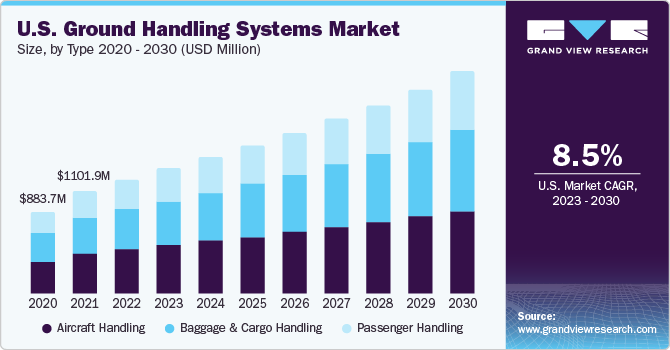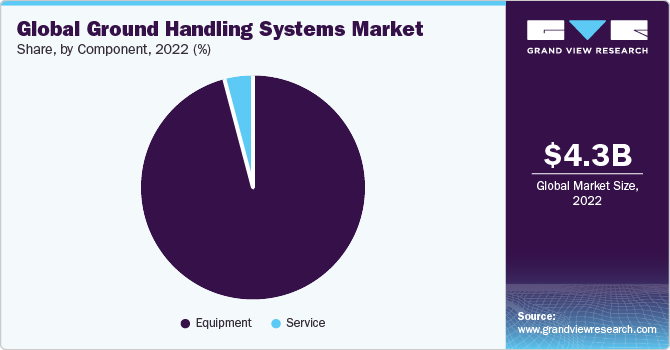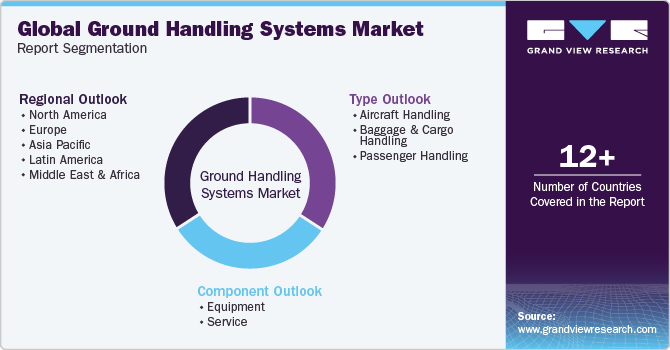- Home
- »
- Automotive & Transportation
- »
-
Ground Handling Systems Market Size & Share Report, 2030GVR Report cover
![Ground Handling Systems Market Size, Share & Trends Report]()
Ground Handling Systems Market Size, Share & Trends Analysis Report By Type (Aircraft Handling, Baggage & Cargo Handling), By Component, By Region, And Segment Forecasts, 2023 - 2030
- Report ID: 978-1-68038-795-7
- Number of Report Pages: 75
- Format: PDF, Horizon Databook
- Historical Range: 2018 - 2021
- Forecast Period: 2023 - 2030
- Industry: Technology
Ground Handling Systems Market Trends
The global ground handling systems market size was valued at USD 4.33 billion in 2022 and is expected to grow at a compound annual growth rate (CAGR) of 9.0% from 2023 to 2030. Increasing globalization has significantly increased global air traffic, which in turn has elevated the importance of ground support operations at airports. Air travel has gained prominence due to decreasing airfares, growing aircraft fleets, enhanced facilities, and the luxury associated with it. It has extended the growth in ground support services that play a key role in offering the convenience of travel to passengers.

Airport operators and airline companies across the globe are increasingly using sophisticated technologies to streamline every aspect of ground handling (GH) operations. On account of frequent innovations in robotics, digital communications, and other innovative technologies, airports have many options to improve this aspect of airport operations which is under intense scrutiny.
Airport authorities across the globe are moving away from fuel-burning ground movements to electric propulsion wherever feasible. Various airline GH service providers are developing electric and biogas fuel-powered towing vehicles for aircraft allowing engines to remain powered off until the aircraft is at the runway’s head.
The industry incorporates considerable opportunities for future growth owing to the increasing number of operational airports and flights across the globe. Rapid technological advancements and developments in using alternative fuel for handling equipment and vehicles are presumed to provide considerable opportunities for industry growth. However, operations optimization during peak time is anticipated to challenge industry growth over the forecast period.
Type Insights
Based on type, the market is segmented into aircraft handling, baggage & cargo handling, and passenger handling. The aircraft handling segment accounted for the largest revenue share of nearly 38.9% in 2022. The increasing global air passenger traffic is a major factor driving the demand for aircraft handling services. With more people traveling by air, there is a greater need for efficient and timely aircraft handling during ground operations. Additionally, the growth of the e-commerce industry has led to a rise in air cargo transportation, further driving the demand for aircraft handling services.
Furthermore, the focus on improving operational efficiency and reducing turnaround time at airports is another driver for the growth of the Aircraft Handling segment. Airlines and airports continuously strive to enhance their operational capabilities and provide a seamless travel experience to passengers. Efficient aircraft handling is crucial in achieving these objectives by minimizing delays, optimizing resource allocation, and streamlining processes.
The baggage & cargo handling segment is estimated to register the fastest CAGR of 9.7% over the forecast period. Baggage and cargo support equipment includes carts, tractors, loaders, trailers, and container loaders. Several factors, such as customer satisfaction, enhancement of aircraft turnaround time, improvement of airport efficiency, modernization of airports, and increased air travel, have driven the growth of the baggage and cargo support equipment segment.
Component Insights
Based on component, the market is segmented into equipment and service. The equipment segment accounted for the largest revenue share of over 96.1% in 2022. The aviation industry is increasingly conscious of its environmental footprint and strives to reduce carbon emissions and minimize waste. As a result, there is a demand for eco-friendly equipment that incorporates energy-efficient technologies, utilizes sustainable materials, and reduces noise pollution. Airport operators and airlines actively seek ground handling equipment that aligns with their sustainability goals, driving innovation and investment in eco-friendly solutions.

The service segment is estimated to register the fastest CAGR of 14.8% over the forecast period. The growing focus on enhancing the passenger experience drives the demand for high-quality ground handling services. Airlines and airports increasingly invest in services prioritizing passenger comfort, convenience, and safety. It includes efficient check-in processes, streamlined baggage handling, and improved customer service, all of which fall under the service segment of the ground handling system market.
Regional Insights
North America dominated the market and accounted for the largest revenue share of nearly 32.9% in 2022. The region has many major airports and airlines, leading to high demand for efficient ground-handling services. Additionally, North America is a popular destination for both domestic and international travel, resulting in increased air traffic and the need for streamlined ground operations. The growing air travel trend and the rise of low-cost carriers further propel the demand for ground-handling services.

Moreover, technological advancements play a crucial role in market growth. Adopting automated systems and robotics in ground handling operations improves efficiency, reduces turnaround time, and enhances safety. It has led to increased investments in advanced ground-handling equipment and technologies by North American airport authorities and ground-handling service providers.
Asia Pacific is expected to register the highest CAGR of 10.8% over the forecast period. Hong Kong, Mumbai, Malaysia, and Singapore are the region’s key airports, where most business jet movements occur. These airports are presumed to expand gradually due to the growing traffic. Poised to witness significant growth over the forecast period, China and India are envisioned to witness an increase in domestic traveling due to growth in urbanization and population.
Key Companies & Market Share Insights
The market is highly competitive, and the players are undertaking strategies such as forecast launches, acquisitions, and collaborations to increase their global reach. For instance, in February 2023, Skyway partnered with Moonware to expedite the preparation of ground infrastructure for advanced aerial mobility. Skyway specializes in air traffic navigation and vertiport airspace management, while Moonware utilizes AI-powered software and autonomous ground vehicles for automated aviation ground operations. This strategic partnership aims to seamlessly integrate ground operations into UATM systems, resulting in a streamlined airside workflow and enhanced navigation services from start to finish. By expanding their operation offerings for next-generation facilities, Skyway’s vertiport development department seeks to provide a reliable infrastructure for Urban Air Mobility while delivering the next level of automated traffic services to airline operators. The following are some of the major participants in the global ground handling systems market:
-
aerohandling
-
Alvest
-
Flughafen München GmbH
-
Aviation Services International Group
-
Aviapartner
-
BGS
-
Queensland Airports Limited
-
Cavotec SA
-
Çelebi Aviation
-
dnata
-
Aeroservices
-
SATS Ltd
-
PrimeFlight Aviation Services
-
Oceania Aviation
-
Menzies Aviation Limited
-
Mallaghan
-
JBT
-
IMAI AERO-EQUIPMENT MFG.CO., LTD.
-
HAVAŞ
Recent Developments
-
In May 2023, Menzies Aviation Limited and i6 Group Ltd expanded their partnership and services to four additional airports in England. The collaboration aims to implement innovative fuel management technologies such as Fusion6 and Reconcile6. These technologies offer various benefits, including cost savings, enhanced safety, and real-time fueling information and management.
-
In May 2023, Menzies Aviation Limited and MYAirline announced a joint venture to set up a ground operations firm in Malaysia. Menzies would offer Kuala Lumpur International Airport ground services, primarily catering to MYAirline at Terminal 2. This strategic decision allows MYAirline to maintain its commitment to provide cost-effective travel options and help to keep fares inexpensive for its valued consumers.
-
In October 2022, UL LLC launched a new service that evaluates the compliance of lithium-ion battery-powered aviation ground handling tools with the UL 5840:2022 Standard. This standard assists customers in accelerating the use of battery-powered equipment, achieving lowered carbon emission targets, and qualifying for incentives. UL LLC is assisting the aviation sector in shifting to electric ground support equipment by addressing the safety issues of lithium batteries in aviation equipment, which is critical for meeting carbon emission reduction targets.
-
In September 2022, dnata collaborated with AeroVect to develop and test automated ground support systems. Up to 100 dnata baggage and freight tractors were outfitted for tests with AeroVect driver automation software. With this collaboration, dnata was the first global operator to utilize automated ground support systems on a broad scale.
-
In May 2022, Flight Consulting Group (FCG) partnered with General Aviation Service (GAS) to establish a network of ground handling stations throughout Spain. This collaboration aims to enhance FCG OPS’s services by proactively seeking opportunities to improve customer experiences. With the support of GAS, FCG OPS can now offer a comprehensive range of ground handling services in Spain, including aircraft handling, refueling, flight permit acquisition, and travel services.
Ground Handling Systems Market Report Scope
Report Attribute
Details
Market size value in 2023
USD 4.76 billion
Revenue forecast in 2030
USD 8.71 billion
Growth rate
CAGR of 9.0% from 2023 to 2030
Base year for estimation
2022
Historical data
2017 - 2021
Forecast period
2023 - 2030
Report updated
September 2023
Quantitative units
Revenue in USD million/billion, and CAGR from 2023 to 2030
Report coverage
Revenue forecast, company ranking, competitive landscape, growth factors, and trends
Segments covered
Type, component, region
Regional scope
North America; Europe; Asia Pacific; Latin America; and MEA
Country scope
U.S.; Canada; U.K.; Germany; France; China; India; Japan; South Korea; Australia; Brazil; Mexico; United Arab Emirates; Saudi Arabia; South Africa
Key companies profiled
aerohandling; Alvest; Flughafen München GmbH; Aviation Services International Group; Aviapartner; BGS; Queensland Airports Limited; Cavotec SA; Çelebi Aviation; dnata; Aeroservices; SATS Ltd
Customization scope
Free report customization (equivalent up to 8 analyst’s working days) with purchase. Addition or alteration to country, regional & segment scope
Pricing and purchase options
Avail customized purchase options to meet your exact research needs. Explore purchase options
Global Ground Handling Systems Market Report Segmentation
This report forecasts revenue growth at global, regional, and country levels and analyzes the latest industry trends in each sub-segments from 2017 to 2030. For this study, Grand View Research has segmented the global ground handling systems market report based on type, component, and region:

-
Type Outlook (Revenue, USD Million, 2017 - 2030)
-
Aircraft Handling
-
Baggage & Cargo Handling
-
Passenger Handling
-
-
Component Outlook (Revenue, USD Million, 2017 - 2030)
-
Equipment
-
Service
-
-
Regional Outlook (Revenue, USD Million, 2017 - 2030)
-
North America
-
U.S.
-
Canada
-
-
Europe
-
UK
-
Germany
-
France
-
-
Asia Pacific
-
China
-
Japan
-
India
-
Australia
-
South Korea
-
-
Latin America
-
Brazil
-
Mexico
-
-
Middle East and Africa
-
United Arab Emirates (UAE)
-
Saudi Arabia
-
South Africa
-
-
Frequently Asked Questions About This Report
b. The global ground handling systems market size was estimated at USD 4.33 billion in 2022 and is expected to reach USD 4.76 billion in 2023.
b. The global ground handling systems market is expected to grow at a compound annual growth rate of 9.0% from 2023 to 2030 to reach USD 8.71 billion by 2030.
b. North America dominated the ground handling systems market in 2022 by holding a revenue share of over 32.0%. The high market share of the region can be attributed to rising investments in smart city projects and smart airport developments, along with the rapid expansion of the aviation industry.
b. The key players in this ground handling systems market include Cavotec SA, SATS Ltd., Saab Group, Air T Inc, ALVEST, Swissport International Ltd., Worldwide Flight Services, Dnata, John Bean Technologies Corp., Tronair Inc., Vestergaard Company, Textron Inc., Ground Support Specialists LLC, Airbus, and Cargotec, among others.
b. Key factors that are driving the market growth include an increase in the construction of new airports, expansion of existing airports to enhance airport passenger and cargo handling capacity, in addition to rapid post-corona pandemic recovery of the market owing to an increase in passenger traffic at airports worldwide.
Share this report with your colleague or friend.
![gvr icn]()
NEED A CUSTOM REPORT?
We can customize every report - free of charge - including purchasing stand-alone sections or country-level reports, as well as offer affordable discounts for start-ups & universities. Contact us now
![Certified Icon]()
We are GDPR and CCPA compliant! Your transaction & personal information is safe and secure. For more details, please read our privacy policy.
We are committed towards customer satisfaction, and quality service.
"The quality of research they have done for us has been excellent."





